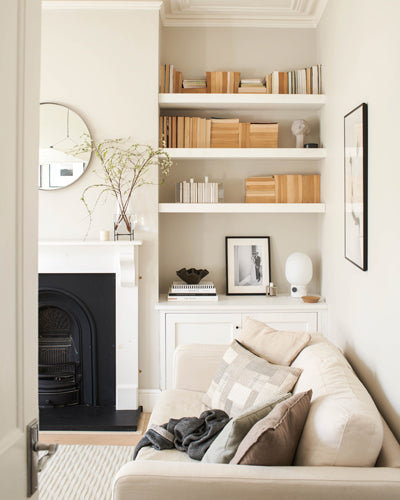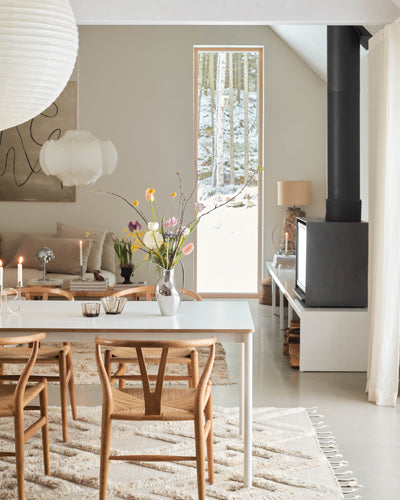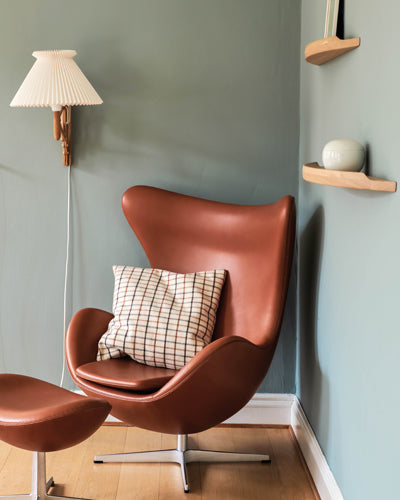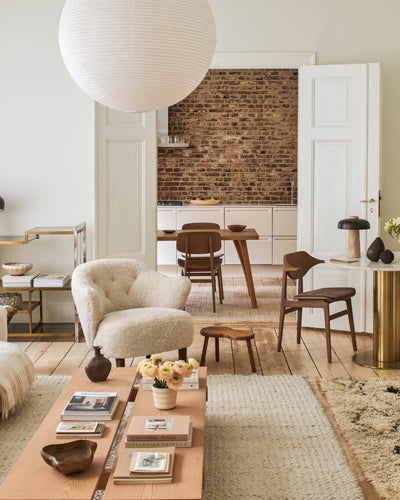In Conversation With Abi Dare
Ahead of releasing her first book 'The Soft Minimalist Home' we sat down with Abi to understand more about the book and what a soft minimalist home means to her.
{gallery blog-gallery-zcyd3az3}
What inspired you to write The Soft Minimalist Home? Was there a particular moment or experience that sparked the idea?
I’ve been styling minimalist interiors and writing about them on my blog for 10 years now, and I know they can bring real benefits to our mood and wellbeing. But I found myself getting frustrated with the common misconception that they’re bland, impractical and soulless. I wanted to show that minimalist spaces can be cosy, full of character and compatible with real lives and homes. The book encapsulates my blog and its ethos, I guess.
How do you define ‘soft minimalism’ and how does it differ from traditional minimalist design?
It’s warm, liveable and inviting, with layers of texture and light. But most importantly, it’s highly individual and it reflects people’s personalities, needs and stories. It’s not necessarily about living with less – it’s about freeing up space for the things we truly cherish, whether that be an art collection, hobbies, family heirlooms, books, certain design pieces or something else.
Do you have a favourite room or home from the book that exemplifies the soft minimalist approach?
I honestly can’t pick one space over another. Every home in the book is different, and there’s everything from small city apartments to seaside cottages to new-build family houses. But what they all have in common is the way they use soft, minimalist decor to celebrate the personal style and passions of the people who live in them. One home, for instance, showcases the inhabitants’ love of art and antiques; another has been designed to create a connection with the owners’ prized garden. I find them all equally inspiring.
What are the key principles of soft minimalism that homeowners can easily incorporate into their spaces?
No matter what your personal taste, there are several key elements of soft minimalist décor – things that will ensure your home is cosy and inviting rather than cold or stark. Texture is vital for adding interest and warmth, as is effective lighting – and the latter always works best when there are layers of different light sources rather than a single, glaring overhead fixture. Incorporating good storage is also important, as is a finding the right layout – arranging your space so that it accommodates all the activities you need it to, with enticing focal points, a good sense of flow and clearly defined zones. These elements and more are covered in the book, and alongside peeks inside real homes there are advice-based spreads with lots of practical, easy-to-implement tips.
How important are colour palettes in achieving a soft minimalist look? Do you have any go-to colours?
Colour choices always have a big impact on the way a space looks and feels, but in a minimalist interior they’re particularly important. Without much visual clutter to divert attention, they really do take centre stage, so choosing colours that resonate with you emotionally and create the mood you want is vital. For many people, that’s calming neutrals – and personally I’m always drawn towards soft beiges and off-whites with a gentle, uplifting warmth. But minimalist interiors certainly don’t preclude bright colours, and in fact several homes in the book have vibrant palettes. The key is working out what colours make you happy, and then how to best use them with the space and light you have in your home.
What are some common challenges people face when trying to adopt a minimalist lifestyle, and how do you suggest overcoming them?
There’s so much noise and chatter around the way we decorate and furnish our homes – pressure to follow constantly changing trends, magazines and social media telling us we should do things this way or that. I think one of the biggest challenges is trying to block all that out and focus on what we truly want. It’s always worth taking the time to step back and drill down into what makes you tick and what brings you joy – in your own home, that’s all that really matters, not what other people think.There’s also a myth that adopting a minimalist approach means getting rid of loads of things and having very few possessions, which can seem overwhelming and unachievable. It doesn’t – it simply means doing away with stuff that doesn’t hold any meaning or value for you in order to create more space for the stuff that does. If you reframe it in that way, it’s much less daunting and much more attainable.
{gallery blog-gallery-icz1vnvz}
Are there any upcoming projects or collaborations you're excited about that you can share with us?
I’d love to write another book, so I hope I can make that happen! Other than that, I’m working on some schemes for interior design clients, as well as some styling and photography work for various brands which I’ll share on my blog and Instagram soon.
In your book, you mention several products available on our website. How do these items embody the principles of soft minimalism, and why did you choose to highlight them?
All the pieces that I highlighted in the book enhance the spaces they sit in – be it a Carl Hansen & Søn ‘CH25’ chair that adds tactile paper cord, a GUBI chrome ‘Multi-Lite’ lamp that introduces an element of contrast to a rustic scheme, or a RAAWII jug that provides a splash of colour. They’ve all been chosen with intention, and they’ve all helped people to craft homes that are tailored to them. They prove that good design can shape the way a space makes us feel and tell a story.
Can you share a few of your favourite products from our collection that align with the soft minimalist aesthetic? How would you style them in a home?
I love products that add texture or that act as statement pieces within a minimalist space. Lounge chairs such as Audo Copenhagen’s ‘Ingeborg’ chair and &Tradition’s ‘Little Petra’ chair, which are featured in homes in the book, do both, as they combine beautifully soft upholstery with gorgeous curves. They’re also incredibly comfortable! You also have a wonderful selection of lighting, which as I mentioned before is a vital part of soft minimalist decor. I like seeing sculptural pendants such as New Works’ ‘Tense’ light or HAY’s ‘Bubble’ pendants used as focal points over sitting areas, beds or dining tables, with a variety of cosy floor and table lamps dotted at different heights around the space. Portable lamps can be particularly useful, as you can place them wherever you want without having to worry about trailing cables or whether there’s a plug socket nearby.
How do you recommend incorporating products from our website to achieve the look and feel described in your book? Are there particular pieces that you consider must-haves?
In a minimalist interior, nothing is there just for the sake of it, so it’s important to look out for pieces that are beautiful, timeless and functional. Mid-century Scandinavian designers tended to achieve this balance brilliantly, and there are plenty of classics from the 30s, 40s, 50s and 60s that look just as good today as when they were first launched. Arne Jacobsen’s ‘Egg’ chair, Louis Poulsen’s ‘PH5’ light and the iconic ‘Wishbone’ chair, designed by Hans J. Wegner for Carl Hansen & Søn, are all excellent examples and they’re incredibly versatile to boot – the ‘Wishbone’ chair, for instance, appears in four very different ways in four very different homes in the book. That said, individuality is key to my take on soft minimalist décor, so there aren’t really any ‘must-haves’. Instead, it’s about selecting pieces that suit you, your style and your needs. Give yourself permission to invest in design that you know you’ll love for decades to come, rather than trying to conform with fleeting trends, and you can’t go far wrong.
Images by Benjamin Edwards © Ryland Peters & Small, taken from The Soft Minimalist Home by Abi Dare (Ryland Peters & Small, £35)











